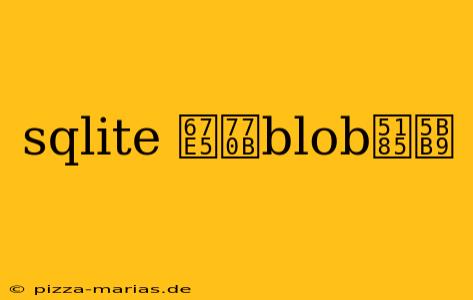SQLite's BLOB (Binary Large Object) data type is versatile, storing various binary data like images, audio, or documents. However, directly viewing the contents of a BLOB within the SQLite shell isn't straightforward. This guide details multiple methods to effectively examine BLOB data stored in your SQLite databases.
Understanding SQLite BLOBs
Before diving into viewing techniques, let's clarify what BLOBs are and why viewing them requires special handling. A BLOB is essentially a container for raw binary data. Unlike text or numeric data, it doesn't have a readily human-readable format. To see the contents, you need to convert it into a format you can interpret, such as hexadecimal representation or by loading it into an appropriate application.
Methods for Viewing SQLite BLOB Content
Several approaches exist for examining the content of BLOBs within your SQLite database. The best method depends on the type of data stored in the BLOB and your preferred viewing method.
1. HEX Encoding in the SQLite Shell
The simplest way to view a BLOB is to convert it to its hexadecimal representation. This shows the raw byte data, useful for comparing BLOBs or analyzing their structure. Here's how:
SELECT HEX(blob_column) FROM your_table WHERE id = 1;
Replace blob_column with the name of your BLOB column and your_table with the table's name. id = 1 filters the results to a specific row; adjust as needed. The output will be a long string of hexadecimal characters representing the BLOB's contents.
2. Extracting BLOBs for External Viewing
For larger BLOBs or complex binary data like images, converting to hex may not be practical. It's often more beneficial to extract the BLOB and open it using a suitable external program.
2.1 Using sqlite3 command-line tool (for Linux/macOS):
The sqlite3 command-line tool offers a simple way to export a BLOB to a file.
sqlite3 your_database.db ".output blob_data.bin" "SELECT blob_column FROM your_table WHERE id = 1;"
This command exports the BLOB to blob_data.bin. You can then open this file using an appropriate application based on the BLOB's content (image viewer for images, text editor for text files, etc.).
2.2 Programming Languages (Python Example):
Programming languages provide more flexible control. The following Python code snippet demonstrates how to extract and handle a BLOB:
import sqlite3
conn = sqlite3.connect('your_database.db')
cursor = conn.cursor()
cursor.execute("SELECT blob_column FROM your_table WHERE id = 1")
blob_data = cursor.fetchone()[0]
with open('blob_data.bin', 'wb') as f:
f.write(blob_data)
conn.close()
This script retrieves the BLOB, saves it to blob_data.bin, and then closes the database connection. Remember to adjust file paths and table/column names accordingly.
3. Handling Specific BLOB Types
The best method hinges on the BLOB's content:
- Images: Extract the BLOB and open it with an image viewer. File extensions (like
.jpg,.png) might be required. - Text: If the BLOB contains text encoded in a specific format (e.g., UTF-8), you might need to decode it appropriately after extraction.
- Other binary data: Hexadecimal representation offers insight into the raw data structure.
Troubleshooting and Best Practices
- Database Connection: Ensure you have correctly established a connection to your SQLite database.
- Table and Column Names: Verify the accuracy of your table and column names in SQL queries.
- Error Handling: Include error handling in your code to gracefully manage potential issues.
- Large BLOBs: For extremely large BLOBs, consider streaming the data to avoid memory issues.
By combining these methods, you can efficiently examine and understand the content of your SQLite BLOBs. Remember to always handle binary data appropriately and use the method best suited for your specific needs. This detailed approach ensures effective management of BLOB data within your SQLite projects.
